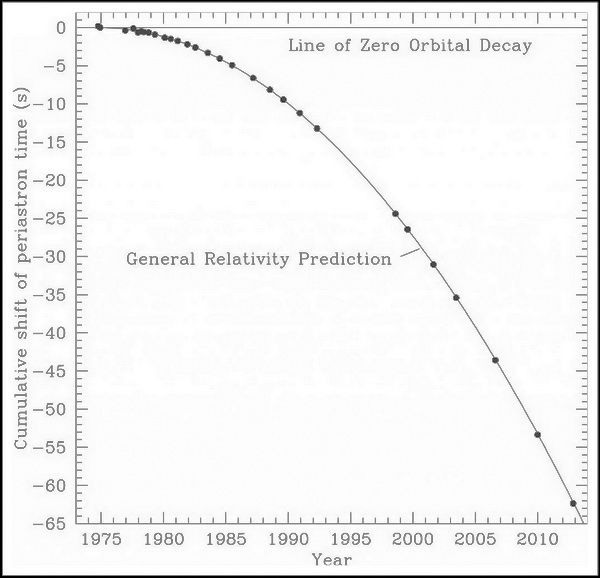Two recent discoveries support for the beginning of the universe (the Big-Bang) and General Relativity. This adds an almost unassailable position of creation ex nihilo as well as more evidence against multiverses… which have no evidence.
GRAVITY WAVES:
BINARY PULSAR:
Binary Pulsar Affirms General Relativity and Cosmic Creation Event
The most rigorous and compelling proof that the universe was created by an Agent that transcends space and time comes from the theory of general relativity. The best confirmation that general relativity is a true theory comes from measurements on the binary pulsar B1913+16. Thanks to a new study, that best confirmation has now become even better.
Astronomers have been studying the binary pulsar PSR B1913+16 for nearly four decades. In a recent issue of the Astrophysical Journal, astronomers Joel Weisberg and Yuping Huang published their analysis of 9,257 pulse times-of-arrival measurements taken over 35 years on PSR B1913+16.1
PSR B1913+16 is a pair of neutron stars where one of the neutron stars is a pulsar. The two neutron stars orbit one other with a period of 7.75 hours and an orbital separation of just 3 light seconds (a little more than twice the separation of the moon from Earth or about 2/3 the diameter of the sun). The pulsar rotates on its axis about 17 times per second. Thus, it sends out a strong pulse of radiation every 59 milliseconds.
The theory of general relativity predicts that neutron stars orbiting close to one another will radiate gravitational waves. This radiation will cause the neutron stars to experience a decay in their orbit—that is, the neutron stars will orbit closer and closer to one another as gravitational energy is radiated away by the gravitational waves.
The easiest and most accurate way to measure the orbital decay is to determine changes in the timing of periastron of the orbit. Periastron refers to the position in the orbit at which two stars orbiting one another are closest to one another. The orientation of periastron in PSR B1913+16’s orbit has been observed to change by 4.2° per year. Figure 1 shows the observed change in the timing of periastron with date from 1975–2003 compared to what the theory of general relativity would predict.2
[….]

[….]
The most potent of the space-time theorems, the one proven by Arvind Borde, Alexander Vilenkin, and Alan Guth, states that all cosmological models are subject to an initial space-time singularity, regardless of assumptions about homogeneity, isotropy (or lack thereof), or energy conditions, including cosmological models that invoke an early hyper-inflation event.9 This beginning of space and time implies that an Agent operating from beyond space and time must have caused the universe to exist.
About a year after the publication of the theorem, Alexander Vilenkin wrote in a book, “With the proof now in place, cosmologists can no longer hide behind the possibility of a past eternal universe. There is no escape, they have to face the problem of a cosmic beginning.”10 That problem is a causal Agent who transcends space and time. Such a causal Agent matches the description of the God of the Bible.
[1] Joel Weisberg and Yuping Huang, “Relativistic Measurements from Timing the Binary Pulsar PSR B1913+16,” Astrophysical Journal 829 (September 2016): id. 55, doi:10.3847/0004-637X/829/1/55.
[2] Joel Weisberg, David Nice, and Joseph Taylor, “Timing Measurements of the Relativistic Binary Pulsar PSR B1913+16,” Astrophysical Journal 722 (September 2010): 1030–34,doi:10.1088/0004-637X/722/2/1030.
[….]
[10] Alexander Vilenkin, Many Worlds in One: The Search for Other Universes (New York: Hill & Wang, 2007), 176.
- RPT “Editors” Note: for more on Vilenkin, see this post: Dr. William Lane Craig Discusses the Borde-Guth-Vilenkin Theorem

